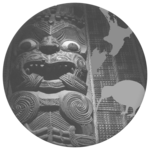User:Paewiki/Radio in New Zealand
| Part of a series on the |
| Culture of New Zealand |
|---|
 |
Radio in New Zealand began in 1922, and is now dominated by almost 30 radio networks and station groups. The Government has dominated broadcasting since 1925, but through privatisation and deregulation have allowed commercial talk and music stations to reach large audiences. New Zealand also has several radio stations serving Māori tribes, Pacific Island communities, ethnic minorities, evangelical Christians and special interests.
State-owned broadcaster Radio New Zealand reaches the broadest range of listeners with bilingual flagship broadcaster Radio New Zealand National. Several previously state-owned radio brands like top-rating talk station Newstalk ZB are now owned by NZME Radio, which operates eight networks on terrestrial radio and iHeartRadio. Ten radio networks are operated by MediaWorks, including top-rating music stations The Edge and The Rock. Independent stations like Port FM, 1XX and Coast FM continue to serve local communities, alongside low-powered and internet stations.
New Zealand was also one of the first countries to introduce Christian radio, with Rhema Media now operating four networks around the country. Student radio began with the start of bFM in 1969 and the first of the country's community access broadcasters was founded in 1981. Te Māngai Pāho funds Māori iwi radio stations, and the Pacific Media Network continues to receive Government support.
History
[edit]Early radio
[edit]| Number (Location) | 1: Northland, Auckland, Bay of Plenty 2: Taranaki, East Coast, Hawkes Bay, Manawatu, Wellington, Nelson, Marlborough 3: Canterbury, West Coast 4: Otago, Southland |
|---|---|
| Letters (Station type) | X_: private station YA: National YC: Concert Z_: public, commercial |
Professor Robert Jack made the first broadcast in New Zealand from the University of Otago physics department on 17 November 1921.[1] The first radio station, Radio Dunedin, began broadcasting on 4 October 1922, but it was only in 1925 that the Radio Broadcasting Company (RBC) began broadcasts throughout New Zealand. In 1932, its assets were acquired by the government, which established the New Zealand Broadcasting Board (NZBB). This would later be replaced by the New Zealand National Broadcasting Service (NBS) and the National Commercial Broadcasting Service (NCBS). In the 1950s, these merged to become the New Zealand Broadcasting Service (NZBS), a government department. In 1962, this gave way to the New Zealand Broadcasting Corporation (NZBC), an independent public body modelled on the BBC in the UK.
Until the 1980s, stations used a series of call signs, consisting of a single digit and two letters (see left). In addition to YA National programme stations, YC Concert programme stations and a limited number of privately owned X stations, several stations were operated commercially by the government. In each region, the largest city was assigned a ZB station (1ZB Auckland, 2ZB Wellington, 3ZB Christchurch and 4ZB Dunedin) and a ZM music station (1ZM Auckland, 2ZM Wellington and 3ZM Christchurch). The Newstalk ZB and ZM brands continue to be used by The Radio Network. The second largest city was assigned a ZA station: 1ZA in Taupo, 2ZA in Palmerston North, 3ZA in Greymouth and 4ZA in Invercargill. In other towns and cities the final letter was assigned from the town or city name such as 4ZG in Gore and 1ZH in Hamilton. These ZA and other stations, also now owned by The Radio Network, have been rebranded as Classic Hits. 1YA, 2YK, 3AQ, 4YA were the first stations operating in the country's four main cities, and 5ZB was a mobile radio station broadcast in railway carriages during the 1940s.[2]
FM broadcasting
[edit]The United Kingdom and New Zealand until recently shared an FM broadcasting allocation of 88.0 – 105.0 MHz. This smaller allocation (less than 20 MHz [i.e.: 88 MHz – 108 MHz], typical of FM in the rest of the world) can be traced to the 405 line system's VHF allocation block. The UK adopted the 405 line system but NZ did not. NZ's allocation for FM remained smaller as if NZ had adopted the 405 line system. New Zealand considered adopting the 405 line system in the late 1950s to early 1960s but adopted PAL instead. This impacted the frequency allocation block for FM broadcasting making it smaller. New Zealand's FM frequency allocation issue was not fixed until the late 1990s, when the band was expanded to the full 20 MHz. Both New Zealand and the United Kingdom have the standard global allocation of 88.0 – 108.0 for FM now. NZ permits Radio Data System subcarriers, but their adoption is not universal. Radio NZ uses RDS for its FM network, but commercial radio's adoption of the technology is not universal.
The very first station to broadcast on FM in New Zealand was a temporary station in Whakatane called FM 90.7. The station ran from the 5 January 1982 until the 31 January 1982. The very first permanent station in New Zealand to broadcast on FM was Magic 91FM in Auckland broadcasting on 91.0FM followed by 89 Stereo FM broadcasting on 89.4FM. Both stations are no longer in operation; Magic 91 is the local Auckland frequency for ZM and 89 Stereo FM today broadcasts a simulcasted FM version of Newstalk ZB. Radio New Zealand started broadcasting on FM in the early 1980s and most networks now broadcast on FM.[3]
References
[edit]- ^ "Dashing heroes of a harbour crossing". Otago Daily Times. 6 September 2008. Retrieved 20 September 2008.
- ^ "Centenary Celebrations". Radionz.co.nz. Retrieved 19 August 2011.
- ^ "TVNZ FM Comes to NZ". YouTube. 1 March 2007. Retrieved 19 August 2011.
